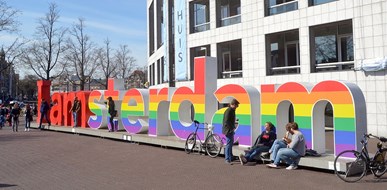City-branding and human rights: a win-win combination?
Published 6 June 2019By Lisa Roodenburg

© Wikipedia Commons. Photo: Erik Swierstra.
After the famous Iamsterdam sign in front of Rijksmuseum was removed, hosts stood in a now empty space to inform confused and disappointed tourists of this fact. The removal of the iconic sign, criticized for becoming a selfie-spot, was a highly symbolic step in the new Amsterdam’s city-branding strategy.
A growing number of local governments make use of marketing strategies to represent their localities in a ‘city-brand’. City-branding means associating selected images related to cultural characteristics, architecture, legal systems, economic opportunities or moral values to a city – in order to create an attractive urban identity. At the same time, cities increasingly use human rights norms to morally position themselves, develop local policies and pursue international relations – all of which has potential in terms of city-branding.
But do the practices of city branding and human rights promotion and implementation go together? Are the branding possibilities merely a bonus when a local government self-identifies as a ‘human rights city’? I will use examples from my three case studies, Hong Kong, Amsterdam and Buenos Aires, to illustrate how city-branding and human rights go together in practice.
City branding in practice
Since the 70s local governments have started to apply marketing methods, among which corporate branding, to local governance. Generally, city branding is used as an instrument to generate economic investments and a competitive position, as well as a way to put forward an identity the cities’ inhabitants can relate to, to create a sense of community.
The emergence of city branding has also led to critique. It is perceived that city branding often puts forward a message that might not represent all residents, often favouring local elites. Regularly, economic objectives are placed centre stage, while the community building element is left behind. In those cases, there is a disconnect between the marketing message and urban reality.
Hong Kong and Amsterdam
Hong Kong has been active in city branding since 1997 through the local government’s office ‘Brand Hong Kong’. After the handover to Mainland China, there was a need to put Hong Kong on the map as a ‘top international city’, in order to remain significant. The branding campaign’s main slogan “Hong Kong, Asia’s World City – connect and excel” seems to prioritize the city’s international attractiveness, which has received skepticism. While human rights do not play an explicit role in the brand Hong Kong campaign, there is a strong emphasis on Hong Kong’s commitment to the rule of law, freedom of expression and association. It is argued that these attributes are chosen because they make Hong Kong stand out from its neighbouring cities in China and Asia.
Amsterdam’s city-branding is quite well-known. The local government launched the Iamsterdam campaign in 2004, which was initiated to speak to both tourists, businesses and inhabitants of Amsterdam. The Iamsterdam slogan aims to make people part of the city, to foster a sense of inclusiveness. However, the campaign has also has received considerable criticism for focusing on tourists and expats rather than inhabitants. Recently, the city council removed the iconic Iamsterdam letters in the city-centre.
While the Iamsterdam campaign does not rely on human rights in an explicit way, there is considerable attention for LGBTI rights in particular. Additionally, in Amsterdam’s international affairs, the city is presented as a human rights city for some time already. During international visits, human rights are presented as the city’s core values, underscored by Amsterdam’s participation in international human rights focused networks such as Solidarity City and Shelter City. The representation of Amsterdam as a human rights city for its inhabitants is more recent. This program has formally launched in 2016.
Alternative example – Buenos Aires
Buenos Aires has been struggling with its city brand. Their previous brand, BUE after the acronym used for Buenos Aires in air traffic, was solely used to promote Buenos Aires as a tourist destination. The brand was discontinued in 2007.
In 2016, the city’s economic and social council has initiated to construct a new city-brand - one that makes Buenos Aires known globally, while also representing Porteños, the inhabitants of Buenos Aires. What it will entail is still unknown. For now, the local government’s marketing strategies seem to be directed at Porteños rather than the international stage. Campaigns such as DisfrutemosBA (let’s enjoy Buenos Aires) and En todo estás Vos (promoting social inclusion and equal opportunities) centre around creating a sense of community. In line with this, the local government generally mobilizes human rights to generate social cohesion rather than an international identity. Buenos Aires’ human rights department is committed to organizing events and projects that promote the city’s diversity and values such as equality.
Human rights branding
Hong Kong, Amsterdam, and Buenos Aires all have different city-branding strategies and human rights take on diverse, yet subtle, roles. In the case of Hong Kong, the absence of human rights is to be expected in light of the sensitive political climate. As for Buenos Aires and Amsterdam, both cities use human rights in their inward message, directed at their inhabitants. While, in Amsterdam, human rights were initially predominantly used in outward, international, communication. Reasoned from a human rights perspective, one could argue that human rights city-branding can come across as an empty promise. However, reasoned from a branding perspective, human rights offer a useful language and help cities to morally position themselves. I would argue that cities’ branding campaigns, at least, come across as more sincere when human rights are mobilized in relation to the cities inhabitants as well.

